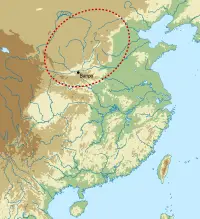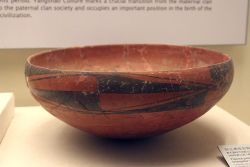Yangshao culture
The Yangshao culture (Chinese: 仰韶文化; pinyin: Yǎngsháo wénhuà) was a Neolithic culture that existed extensively along the valleys of the Wei River and the middle Yellow River (Huanghe) in northern China. The Yangshao culture is dated from around 5000 B.C.E. to 3000 B.C.E. and is one of the earliest settled cultures in China. It is named after Yangshao, the first excavated representative village of this culture, which was discovered in 1921 in Henan Province. The culture flourished mainly in the provinces of Henan, Shaanxi, and Shanxi. Over a thousand Yangshao Culture sites have been found including the Banpo Site in Xian, and Jiangzhai at Lintong County, Shanxi Province. Shanxi it is regarded as the center of this culture because it possesses the most Yangshao sites.
The Yangshao culture exhibits the first evidence of settled agriculture in China, producing millet, wheat, rice, kaoliang, and possibly soybeans. They kept domesticated animals such as pigs and dogs, chickens, sheep, goats, and cattle, hunted, fished with nets, and gathered fruits and nuts. Yangshao is well-known for its red, painted pottery, decorated in white and black with human faces, animal, and geometric designs. Axes and arrowheads were made of polished stone; other artifacts include elaborately worked objects in jade, and flint, bone, and ground-stone objects for daily use such as stone axes, shovels, millstones, arrows, and harpoons.
Introduction
The Yangshao culture (Chinese: 仰韶文化; pinyin: Yǎngsháo wénhuà) was a Neolithic culture that existed extensively along the valleys of the Wei River and the middle Yellow River (Huanghe) in northern China. The Yangshao Culture developed during the Neolithic period (c. 12000 to 2000 B.C.E.) and is dated from around 5000 B.C.E. to 3000 B.C.E.. It is one of the earliest settled cultures in China. The culture is named after Yangshao, the first excavated representative village of this culture, which was discovered in 1921 in Henan Province. The culture flourished mainly in the provinces of Henan, Shaanxi and Shanxi.
Agriculture
The Yangshao people were originally hunter-gatherers who eventually settled into villages which were divided into areas for living, for firing pottery, and for burying the dead. The archaeological site of Banpo village, near Xi'an, is one of the best-known ditch-enclosed settlements of the Yangshao culture. Another major settlement called Jiangzhai was excavated out to its limits, and archaeologists found that it was completely surrounded by a ring-ditch.
The Yangshao show the first evidence of food production in China. The subsistence practices of Yangshao people were varied. They cultivated millet extensively; some villages also cultivated wheat, rice, kaoliang, and possibly soybeans. The millet was ground into flour using mortars and pestles. Millet, rather than rice, is still the staple grain consumed in northern China.
The exact nature of Yangshao agriculture—small-scale slash-and-burn cultivation versus intensive agriculture in permanent fields, is currently a subject of debate. However, Middle Yangshao settlements such as Jiangzhi contain raised floor buildings that may have been used for the storage of surplus grains. They kept such domesticated animals as pigs and dogs, as well as chickens, sheep, goats, and cattle, but much of their meat came from hunting and fishing. They fished with nets, and gathered fruits and nuts, including chestnuts. The Yangshao people may also have practiced an early form of silkworm cultivation. Their stone tools were polished and highly specialized. Other artifacts include elaborately worked objects in jade, and flint, bone, and ground-stone objects for daily use such as stone axes, shovels, millstones, arrows, and harpoons.
Over a 1,000 Yangshao Culture sites have been found including the Banpo Site in Xian, and Jiangzhai at Lintong County, Shanxi Province. Shanxi it is regarded as the center of this culture because it possesses the most Yangshao Culture sites. Villages were of different sizes. Some large ones were strictly laid out, such as Jiangzhai Village, which is divided into dwelling places and cemeteries by dikes. Five architectural groups, each of which had many houses, were scattered around a central square.
The Yangshao buried their dead in round pits, along with food and utensils which indicate the beginnings of ancestor-worship. Females have frequently been found buried in the center of a grave, surrounded by fine pottery and other possessions, suggesting a matriarchal society.[1]
Pottery
The Yangshao culture is well-known for its red painted pottery, one of two major types produced during the Neolithic period in China. Before 2000 B.C.E., Yangshao were making coiled red earthenware that was fired in kilns at 1000°C-1500°C. Axes and arrowheads were made of polished stone and other tools were made of stone chips. Millet was the main crop of the Yangshao. They domesticated two main animals, the dog and the pig, with the pig being the more important, painted in white and black with human faces, animal, and geometric designs such as spirals. It is possible that these highly-decorated pieces were produced specifically for funeral rites. Unlike the later Longshan culture, the Yangshao culture did not use pottery wheels in pottery-making.
Pieces found buried in graves include tall rounded jars, flaring bowls and three-footed bowls which resemble a type of bronze pot (ting) produced in large numbers for ritual purposes during the later Shang dynasty (1750 – 1040 B.C.E.).
The Yangshao phase is followed by that called Lungshan.
Phases
Among the numerous overlapping phases of the Yangshao culture, the most prominent phases, typified by differing styles of pottery, include:
- Banpo phase, approximately 4800 B.C.E. to 4200 B.C.E., central plain. Nearly 10,000 square meters of the settlement at Banpo, on the Wei River in Xi'an, Shaanxi Province, was excavated in the 1950s by the Chinese Academy of Sciences, and was the first large-scale excavation of the People's Republic of China. Forty-six houses were excavated, most of which are circular. Many of the houses were semi-subterranean with the floor typically a meter below the ground surface. The houses were supported by timber poles and had steeply pitched thatched roofs. The settlement is surrounded by a moat, with the graves and pottery kilns located outside of the moat perimeter. A cemetery includes 174 adult burials, most of whom died around the age of 30.[2]
- Miaodigou phase, circa 4000 B.C.E. to 3000 B.C.E., successor to Banpo
- Majiayao phase, approximately 3300 B.C.E. to 2000 B.C.E., in Gansu, Qinghai The earliest discoveries of copper and bronze objects in China occur at Majiayao sites.
- Banshan phase, approximately 2700 B.C.E. to 2300 B.C.E., successor to Majiayao
- Machang phase, approximately 2400 B.C.E. to 2000 B.C.E.
Notes
- ↑ Dorothy Perkins, Encyclopedia of China: The Essential Reference to China, Its History and Culture (Checkmark Books, 2000, ISBN 0816043744).
- ↑ Yangshao Culture (5000 B.C.E. to 3000 B.C.E.), Facts and Details. Retrieved September 12, 2019.
ReferencesISBN links support NWE through referral fees
- Chang, K.C. The Archaeology of Ancient China. New Haven: Yale University Press, 1986. ISBN 0300037848
- Liu, Li. The Chinese Neolithic Trajectories to Early States. New studies in archaeology. Cambridge, UK: Cambridge University Press, 2004. ISBN 0511080565
- Liu, Li, and Xingcan Chen. The Archaeology of China: From the Late Paleolithic to the Early Bronze Age. Cambridge University Press, 2012. ISBN 0521643104
- Perkins, Dorothy. Encyclopedia of China: The Essential Reference to China, Its History and Culture. Checkmark Books, 2000. ISBN 0816043744
- Underhill, Anne P. Craft production and social change in northern China. New York: Kluwer Academic/Plenum Publishers, 2002. ISBN 0306467712
- Watson, William. Ancient China; the discoveries of post-liberation Chinese archaeology. Greenwich, CT: New York Graphic Society, 1974. ISBN 0821206087
Credits
New World Encyclopedia writers and editors rewrote and completed the Wikipedia article in accordance with New World Encyclopedia standards. This article abides by terms of the Creative Commons CC-by-sa 3.0 License (CC-by-sa), which may be used and disseminated with proper attribution. Credit is due under the terms of this license that can reference both the New World Encyclopedia contributors and the selfless volunteer contributors of the Wikimedia Foundation. To cite this article click here for a list of acceptable citing formats.The history of earlier contributions by wikipedians is accessible to researchers here:
The history of this article since it was imported to New World Encyclopedia:
Note: Some restrictions may apply to use of individual images which are separately licensed.


